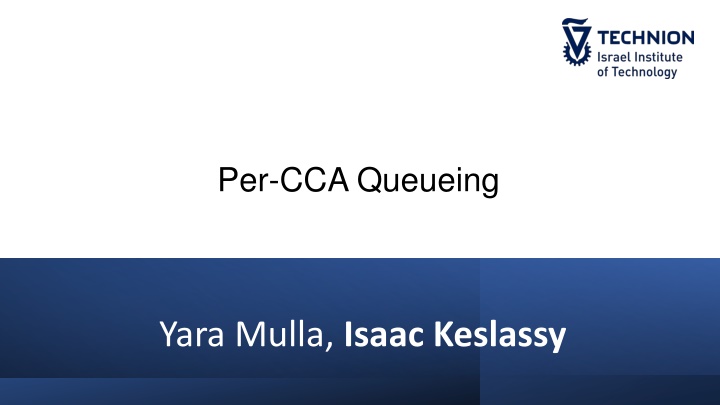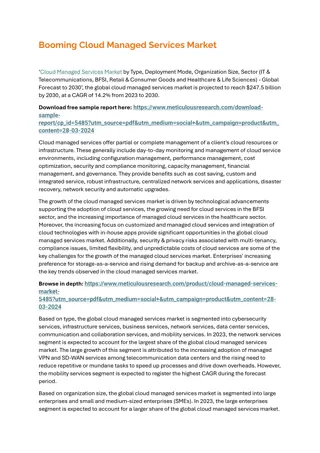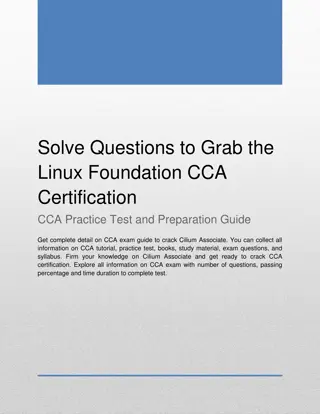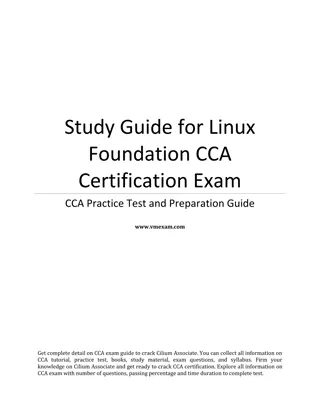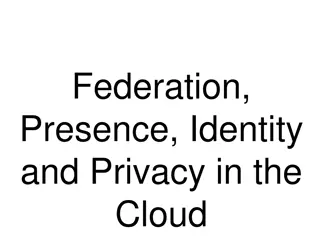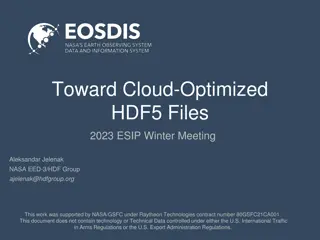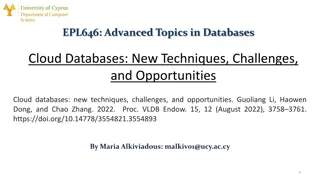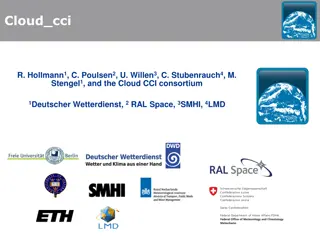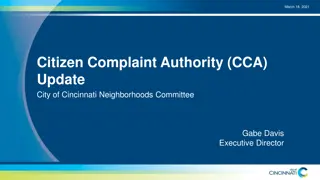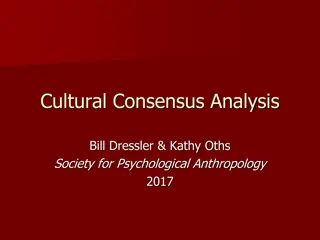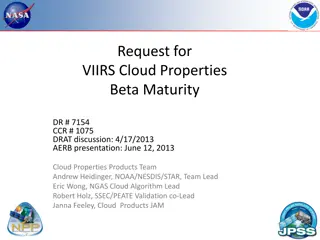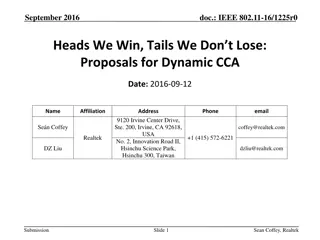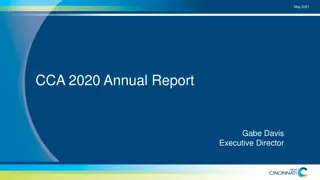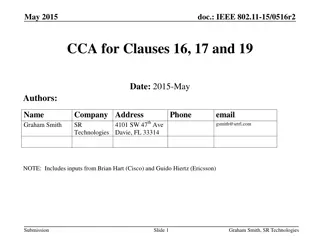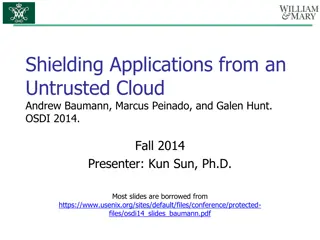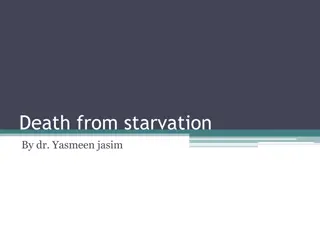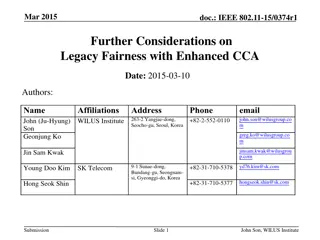Tackling Increasing CCA Starvation in Cloud Environments
Address the challenge of increasing CCA starvation in cloud networks caused by users selecting aggressive CCAs over vanilla ones. Learn how cloud operators can safeguard users employing vanilla CCAs through fair queueing algorithms, per-flow isolation, and ML-based CCA classification.
Download Presentation

Please find below an Image/Link to download the presentation.
The content on the website is provided AS IS for your information and personal use only. It may not be sold, licensed, or shared on other websites without obtaining consent from the author.If you encounter any issues during the download, it is possible that the publisher has removed the file from their server.
You are allowed to download the files provided on this website for personal or commercial use, subject to the condition that they are used lawfully. All files are the property of their respective owners.
The content on the website is provided AS IS for your information and personal use only. It may not be sold, licensed, or shared on other websites without obtaining consent from the author.
E N D
Presentation Transcript
Per-CCA Queueing Yara Mulla, Isaac Keslassy
Problem: increasing CCA starvation Problem: increasing CCA starvation Cloud users can pick any Congestion Control Algorithm (CCA) It is an arms race: they will tend to pick the most aggressive CCAs (like BBRv1) and can starve vanilla CCAs (like CUBIC) in their shared router buffers How can cloud operators protect users with vanilla CCAs? 2
Related work Related work Fair queueing algorithms Per-flow isolation Hard to implement Admission-control algorithms Hits heavy hitters by dropping their packets Assumes all CCAs respond equally to losing packets Fundamental problems: 1) In a shared buffer, each CCA impacts the others Hits heavy hitters in many ways Large oscillations and hurting performance Cebinae [1] 2) Routers don t know flow CCAs no per-CCA congestion feedback (ECN, delay, loss, etc.) Isolation per CCA family (e.g. loss-based, delay- based, etc.) P4air [2], Confucius [3], P4CCI [4] Unfairness within a CCA family [1] L. Yu et al., Cebinae: scalable in-network fairness augmentation, ACM SIGCOMM, 2022. [2] B. Turkovic and F. Kuipers, P4air: Increasing fairness among competing congestion control algorithms, IEEE ICNP, 2020. [3] Z. Meng et al., Confucius queue management: Be fair but not too fast, arXiv, 2023. [4] E. Kfouryet al., P4CCI: P4-based online TCP congestion control algorithm identification for traffic separation, IEEE ICC, 2023. 3
ML ML- -based CCA Classification based CCA Classification Independently: emergence of fast and accurate ML-based CCA classification algorithms, e.g.: DeePCCI [1] Sei r [2] Dragonfly [3] [1] C. Sander et al., DeePCCI: Deep learning-based passive congestion control identification, Workshop on Network Meets AI & ML, pp. 37 43, 2019. [2] K. A. Simpson, R. Cziva, and D. P. Pezaros, Sei r: Dataplane assisted flow classification using ML, IEEE Globecom, pp. 1 6, 2020. [3] D. Carmel and I. Keslassy, Dragonfly: In-flight CCA identification, IFIP Networking, 2023. 4
Per Per- -CCA queueing CCA queueing Na ve Na ve ideal view ideal view Machine Learning CCA Identification Each queue is served proportionally to its estimated number of flows, so each CCA gets its fair share Ideal Ideal CCA isolation classification 5
Ideal per Ideal per- -CCA queueing CCA queueing: : benefits benefits Cloud users can use the CCA that best fits their application without caring about other users. CCA developers can design CCAs that better fit applications and that only need to be fair to themselves. Routers can apply the best feedback to each CCA (e.g. ECN or short buffer) 6
Per Per- -CCA queueing with real CCA queueing with real- -life classifiers life classifiers Machine Learning CCA Identification 7
Per Per- -CCA queueing CCA queueing: i : implementation challenges mplementation challenges 1. The CCA classifier should provide a classification after a few RTTs. 2. It should automatically learn to classify CCAs without a need to define CCA protocols manually. 3. It should do so while only locally examining the packets at the router buffer. 4. It should be accurate enough to get a good queue isolation. What is the needed accuracy? 5. It should classify dozens of CCAs. 6. It should be able to separate elephants to classify urgently and mice that can stay in some unclassified queue. 7. It should deal with re-classifications. 8. It should deal with unknown CCAs. 9. It should deal with different RTTs. 10. It should be able to approximate the number of flows per queue for a fair service rate. 11. It should remember classifier decisions. 8
How classifier accuracy impacts performance How classifier accuracy impacts performance Model outline Model outline Flow distribution Classifier accuracy (1) How many flows from each CCA in each queue Machine Learning CCA Identification Model uses fundamental results in classification theory Flow distribution Packet distribution (2) 1) Simple aggressiveness model: the throughput ratio of a BBR flow to a CUBIC flow is constant 2) Advanced aggressiveness model: this ratio depends on the percentage of BBR and CUBIC flows Performance Packet distribution (3) Throughput of each CCA 9
Evaluations Evaluations 10
Parameters Parameters Mininet emulation 150 flows (3 CCAs, 50 hosts per CCA, 1 flow per host) Link delay: ? = 10?? = 0.01[???] Link capacity: ? = 1.5[Gbps] ? =? ??? 1[Packet]=1.414[KBytes], N=150flows Buffer size: ~460 ??????? , ? Reno hosts ????? ? CUBIC hosts server switch ARBITER ?????? ? ???? BBR hosts 11
??score score Prediction Classifier s accuracy measured by F1score Reno CUBIC BBR ?????? Reno FN FN 0 ?1 1 , ?1= 1 for a perfect classifier ??????? TRUE CUBIC FP ????? BBR FP ?? ????????? = ?? + ?? ?? ?????? = ?? + ?? ?1=2 ????????? ?????? ????????? + ?????? ?? = ?? +1 2(?? + ??) ?? ????? ?1????? = ?? +1 2 ?? + ?? 12
Throughput share of the most vulnerable CCA Throughput share of the most vulnerable CCA We look at the throughput share of the most vulnerable CCA as a function of classifier ?????????????? ??? ???? ???? ????? min ? accuracy: In a shared buffer (blue line) we can see how the most vulnerable CCA is starved Per-CCA queueing reduces this starvation The advanced aggressiveness model is accurate 13
Classifiers from the literature Classifiers from the literature DeePCCI CCA classifier[1] Dragonfly CCA classifier[2] [1] C. Sander, J. R th, O. Hohlfeld, and K. Wehrle, DeePCCI: Deep learning-based passive congestion control identification, in Workshop on Network Meets AI & ML, 2019 [2] D. Carmel and I. Keslassy, Dragonfly: In-flight CCA identification, in IFIP Networking, 2023 14
Conclusion Conclusion Main idea: per-CCA queueing With per-CCA queueing, we can design and use the best CCA for each application, without caring about CCAs of other users Current CCA classifiers are already sufficiently accurate to strongly reduce starvation Per-CCA queueing still needs to solve several implementation challenges to be widely used 15
